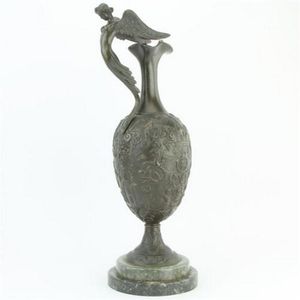Bronze Renaissance Ewer with Winged Caryatid Handles and Three Graces
You must be a subscriber, and be logged in to view price and dealer details.
Subscribe Now to view actual auction price for this item
When you subscribe, you have the option of setting the currency in which to display prices to $Au, $US, $NZ or Stg.
- Ewer / Pitcher - A type of jug with a narrow neck bulbous body and wide spout, originally used for carrying and storing liquids such as water or wine. In medieval times they were the source of water to wash ones hands during and after a meal. later the shape was used for vessels in silver, gold, glass and ceramics.
In Victorian times they were made in ceramics and occasionally glass with a matching basin, and sometimes other accessories such as a soap holder or toothbrush holder. Their purpose was to provide facilities for personal washing In the early 19th century were often enclosed in purpose built stands, and later resided on a washstand..
Sometimes the words "ewer" and "pitcher" are used interchangably, but a pitcher is generally considered to be a jug, and would have a wide mouth, and a gently tapering body. - Caryatid - A Greek term that in architecture applies to a carved or cast female figures that acts as a column or pillar, supporting an entablature on her head.
In decorative arts , in furniture of the Renaissance and Classical Revival periods. Male figures are known as Atlantes.
Carved figures are rare on Australian furniture until the later 19th century, Australian craftsmen generally preferring to adopt the designs of the pattern books to rather more simple forms, such as scrolls or columns. - Bronze - An alloy of copper and tin, traditionally in the proportions of about 9 parts of copper to 1 part of tin.
The discovery of bronze in Western Asia in the 4th century enabled people to create metal objects which were superior to those previoulsy possible because of its strength and hardness, and it has been used throughout the world for weapons, coins, tools, statuary and other decorative items.
It is very fluid in a molten state, and its hardness, strength when set, and non-corrosive properties makes it most suitable for casting sculpture. - Oenochoe / Oinochoe - An oenochoe, also spelt oinochoe is an Ancient Greek wine jug or a modern jug usually silver, made in the same form, with a single curved handle and is usually taller than it is wide.
This item has been included into following indexes:
Visually similar items

Anamese Le Dynasty crackle glaze vase, of mallet form, in cream tones, raised on circular foot, height 16 cm

Carved celadon glazed bottle vase the body and neck of the vase beautifully carved with two dragons disporting among bats and clouds under a smooth celadon ground of blue tone stopping neatly above the foot, Qianlong incised six character seal marks. Heigh

John Parker, large lustrous bottle vase, height 35 cm

Guglielmo Berchicci. White E.T.A. Floor lamp manufactured by Kundalini, Italy, fiberglass and steel
